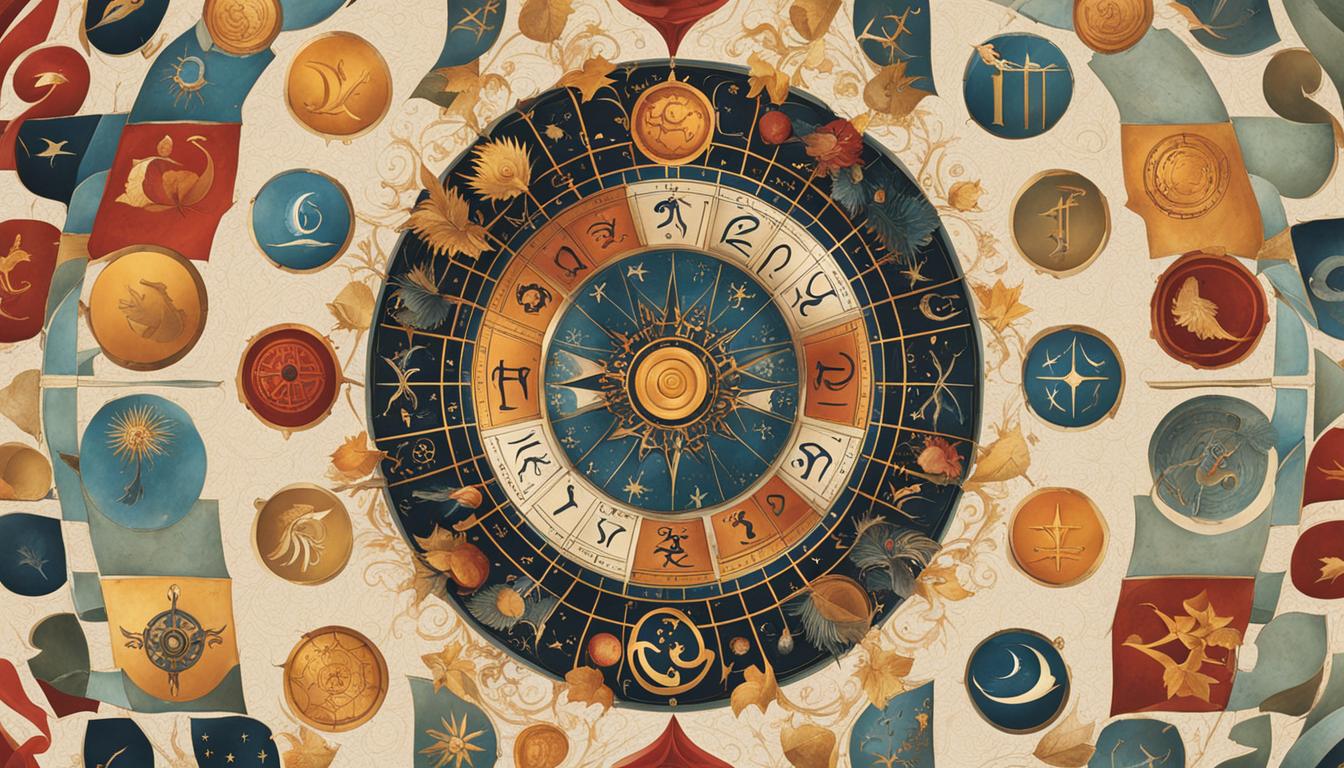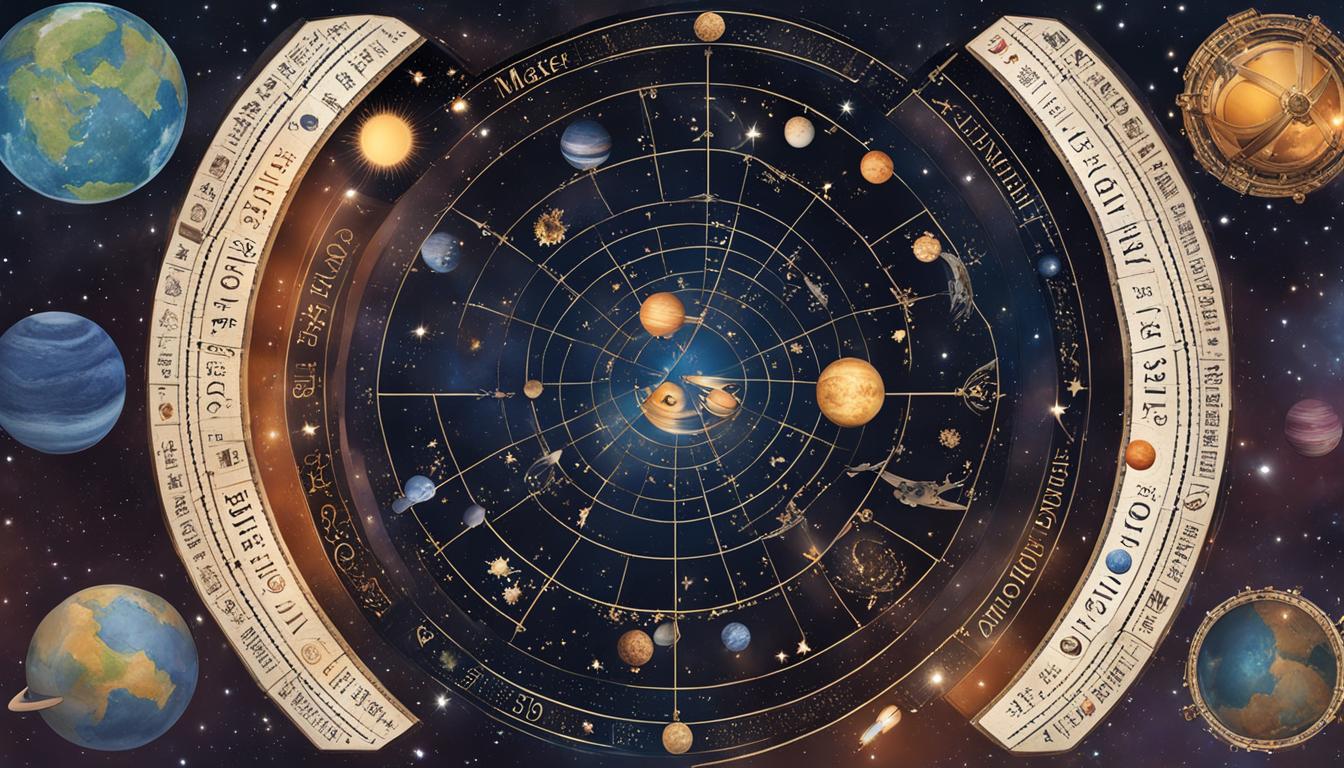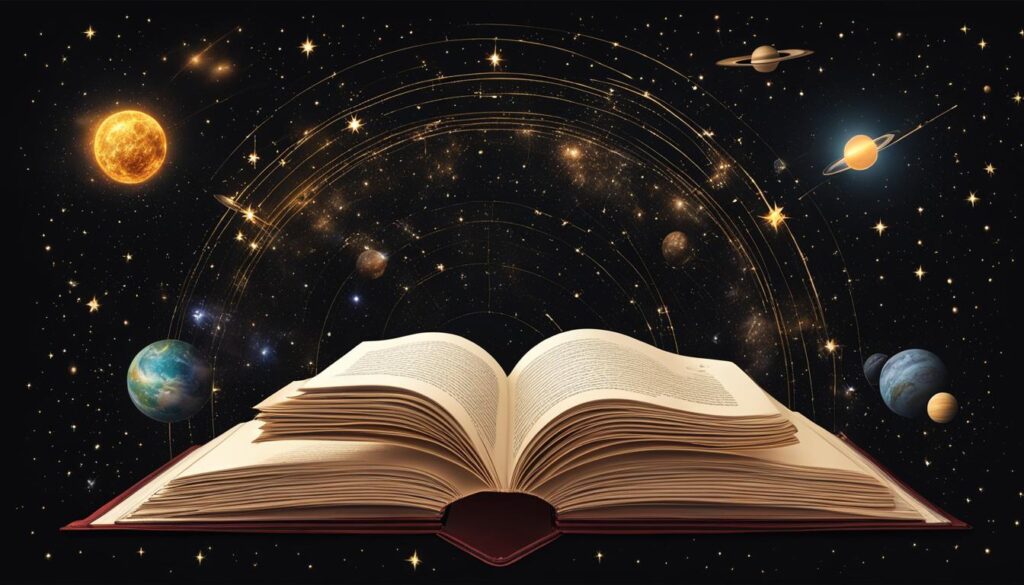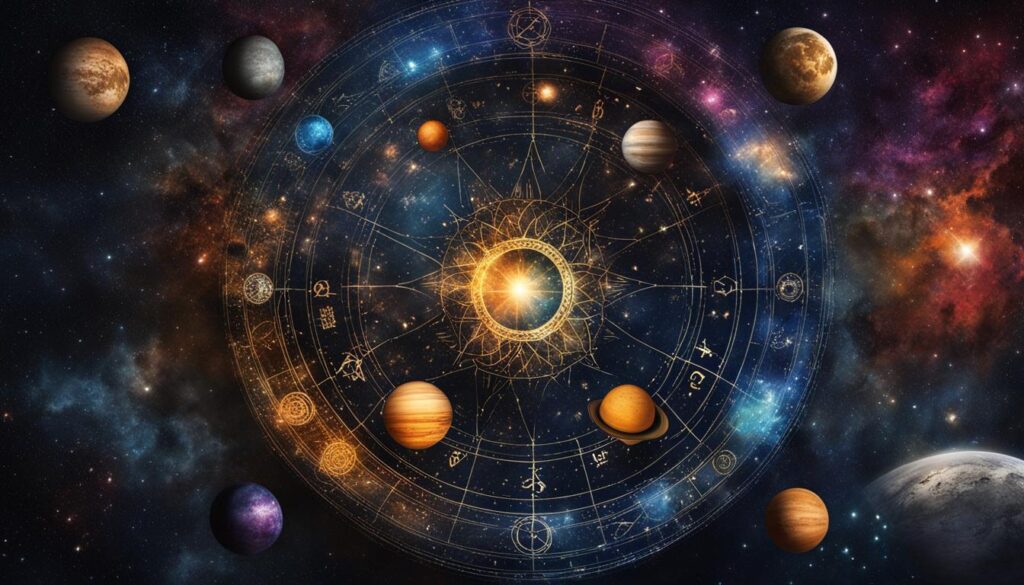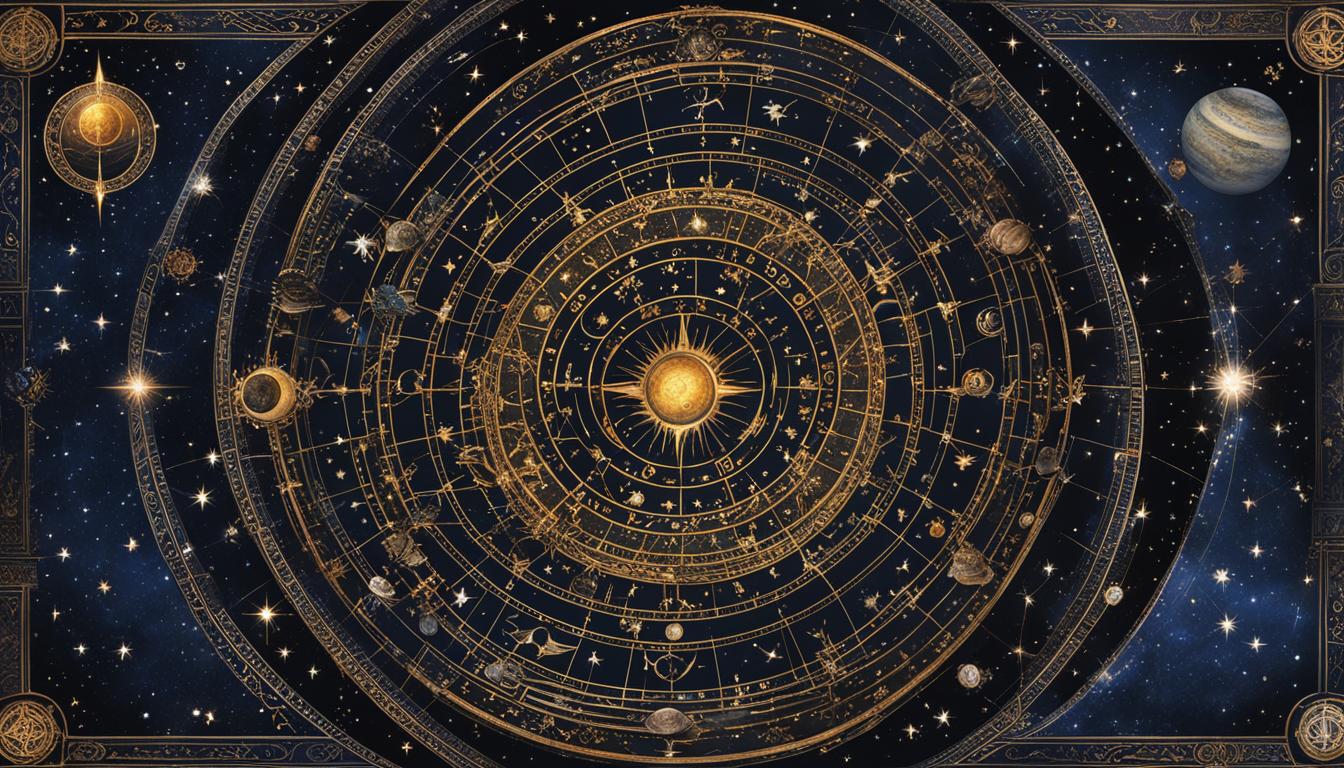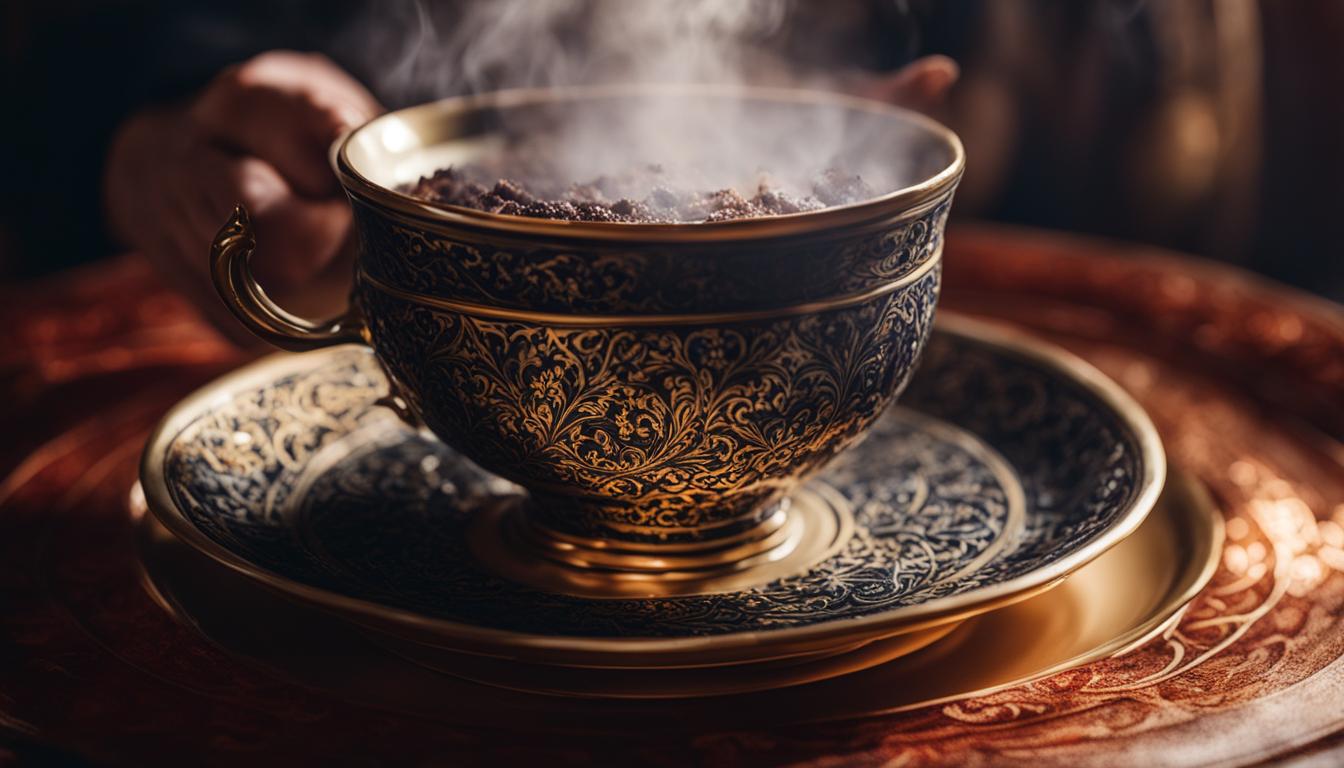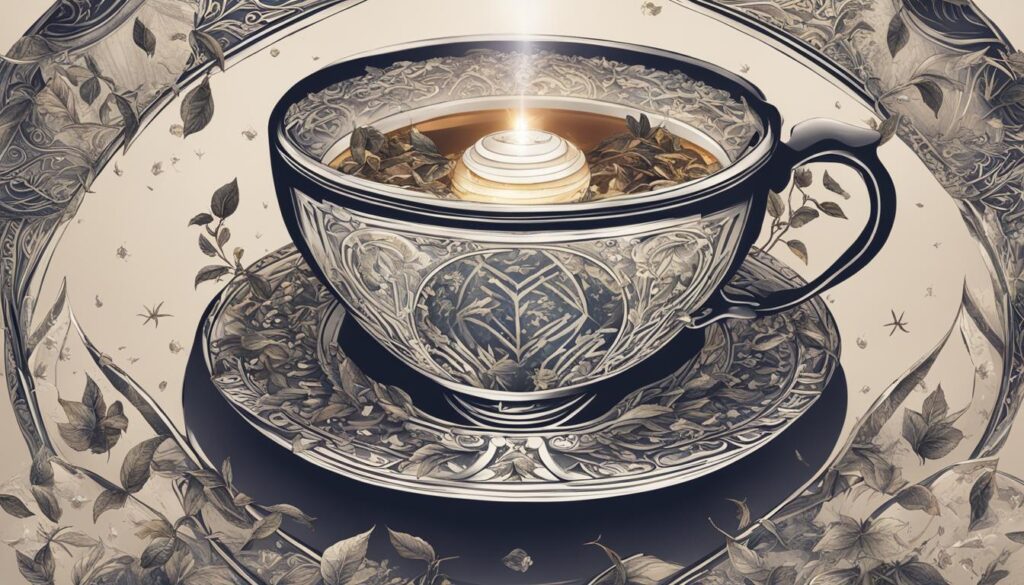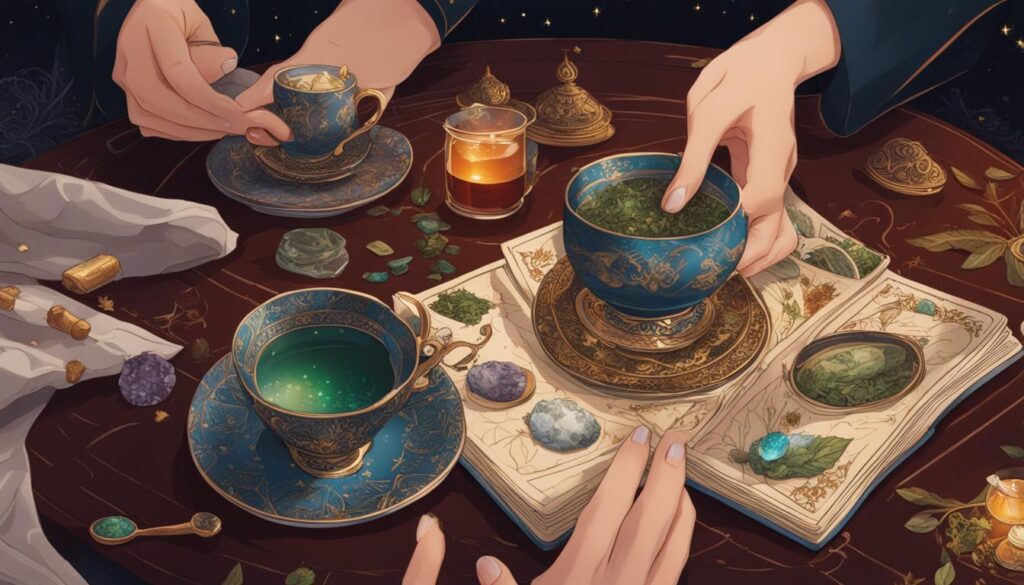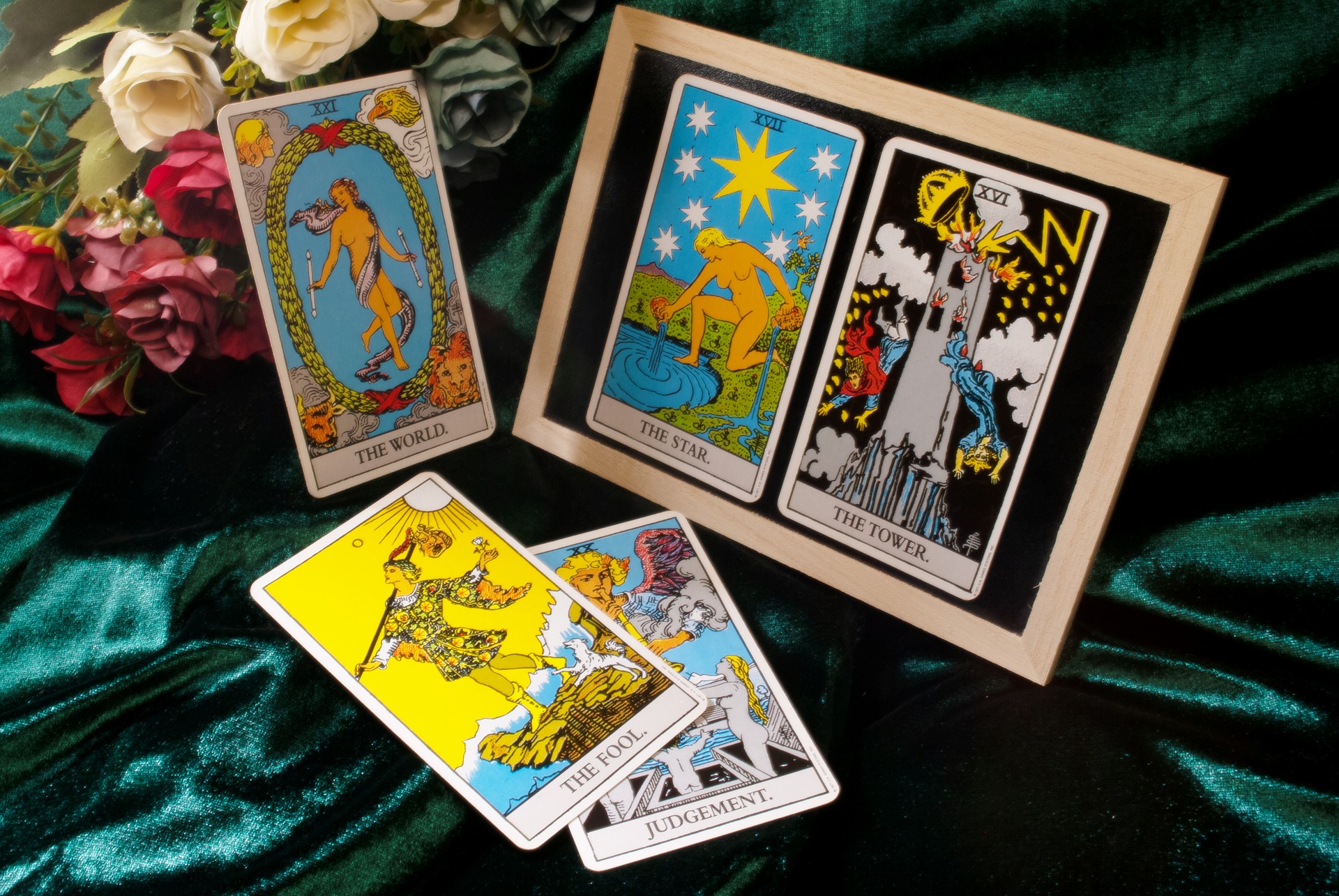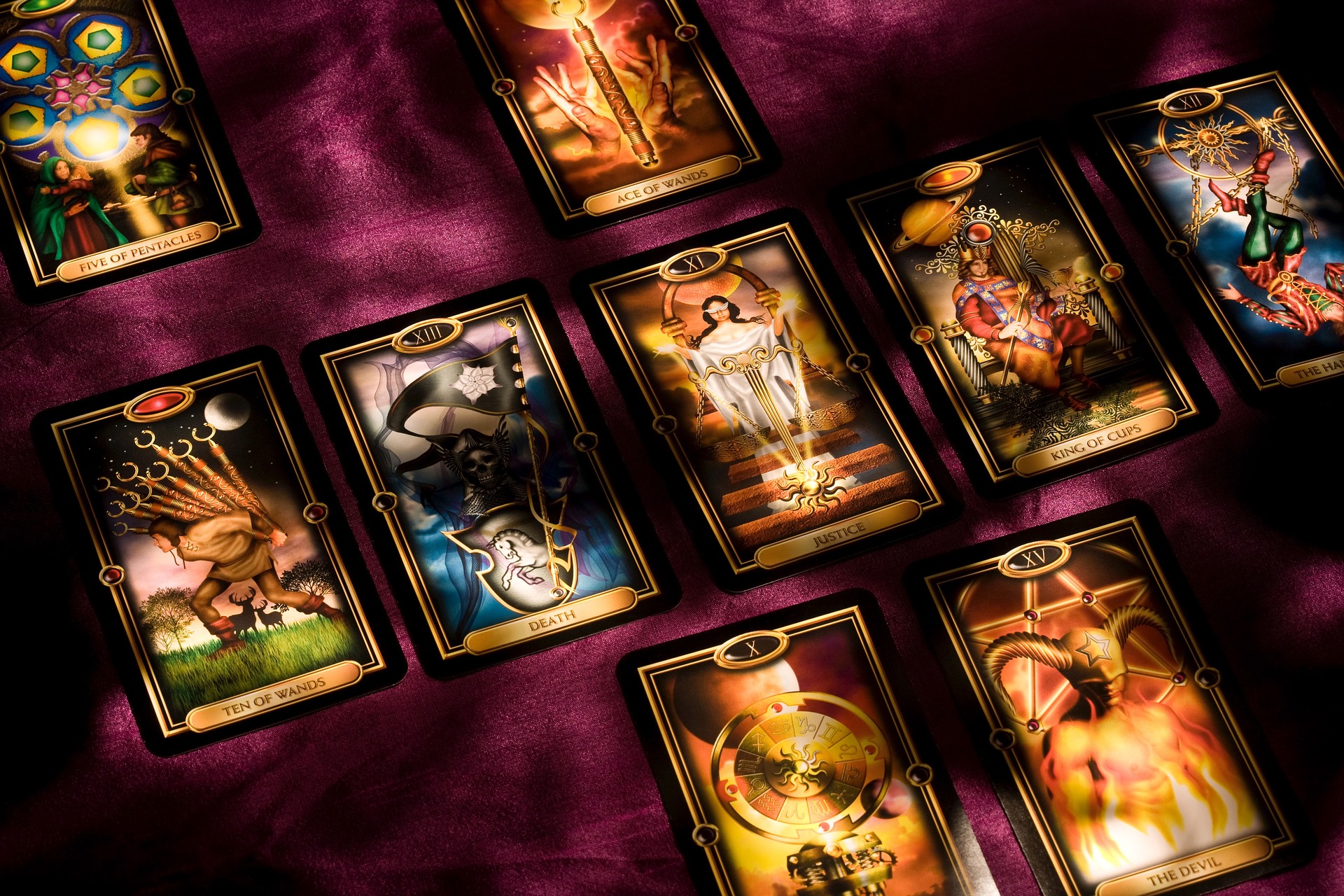Astrology is a fascinating subject that influences various aspects of our lives, from our romantic behavior to our workplace habits. To get a better understanding of astrology, it’s important to know the number of astrology signs or zodiac signs that exist. The zodiac is made up of 12 signs, each with their own specific dates and unique characteristics.
Key Takeaways:
- There are 12 astrology signs or zodiac signs in total.
- Each sign has specific dates and characteristics.
- Astrology influences various aspects of our lives, including romantic behavior and workplace habits.
- Understanding astrology signs can provide insights into our personalities and relationships.
- Exploring the elements and compatibility between signs can enhance our understanding of astrology.
What Do Zodiac Sign Dates Mean?
Zodiac sign dates play a crucial role in understanding astrology and its impact on our lives. Each zodiac sign is associated with specific dates, which are determined based on an individual’s date of birth. These dates help identify a person’s sun sign, which represents the core characteristics and personality traits.
To give you a better understanding, let’s take a closer look at the zodiac sign dates:
| Zodiac Sign |
Date Range |
| Aries |
March 21 – April 19 |
| Taurus |
April 20 – May 20 |
| Gemini |
May 21 – June 20 |
| Cancer |
June 21 – July 22 |
| Leo |
July 23 – August 22 |
| Virgo |
August 23 – September 22 |
| Libra |
September 23 – October 22 |
| Scorpio |
October 23 – November 21 |
| Sagittarius |
November 22 – December 21 |
| Capricorn |
December 22 – January 19 |
| Aquarius |
January 20 – February 18 |
| Pisces |
February 19 – March 20 |
It’s important to note that while zodiac sign dates provide a general understanding of a person’s sun sign, astrology goes beyond just the sun sign. Moon and rising signs also contribute to a person’s character and presentation to others. These signs, along with the sun sign, create a unique astrological profile that reflects the complexity of an individual’s personality.
Understanding zodiac sign dates is the first step in exploring the fascinating world of astrology. By recognizing the significance of these dates and the traits associated with each sign, we gain valuable insights into ourselves and those around us. Stay tuned for the next section where we’ll take a closer look at the unique personality traits and symbolism associated with each zodiac sign.
A Closer Look at Each Zodiac Sign
Each zodiac sign has its own unique personality traits and symbolism. Here’s a brief overview of each sign:
Aries (March 21 – April 19)
Symbolized by the Ram, Aries is known for its fiery and adventurous nature. People born under this sign are often confident, courageous, and ambitious. They possess natural leadership qualities and are not afraid to take risks.
Taurus (April 20 – May 20)
Taurus, symbolized by the Bull, represents stability, reliability, and practicality. Taureans are known for their strong determination and loyalty. They value security and appreciate the finer things in life.
Gemini (May 21 – June 20)
Symbolized by the Twins, Gemini is the sign of duality and versatility. Geminis are often intellectual, curious, and sociable. They have a natural gift for communication and love to engage in lively conversations.
Cancer (June 21 – July 22)
Cancer, symbolized by the Crab, is known for its nurturing and empathetic nature. Cancerians are deeply connected to their emotions and have a strong intuition. They are fiercely protective of their loved ones.
Leo (July 23 – August 22)
Symbolized by the Lion, Leo is the sign of creativity and leadership. Leos are confident, charismatic, and love to be in the spotlight. They have a generous heart and thrive on recognition and admiration.
Virgo (August 23 – September 22)
Virgo, symbolized by the Virgin, represents practicality and attention to detail. Virgos are often analytical, organized, and meticulous. They have a strong sense of responsibility and strive for perfection.
Libra (September 23 – October 22)
Symbolized by the Scales, Libra is known for its balance and harmony. Librans value justice, fairness, and relationships. They are diplomatic, cooperative, and have a natural ability to see both sides of a situation.
Scorpio (October 23 – November 21)
Scorpio, symbolized by the Scorpion, is associated with intensity and transformation. Scorpios are passionate, mysterious, and often possess a magnetic charm. They have a deep desire for emotional connection and are highly intuitive.
Sagittarius (November 22 – December 21)
Sagittarius, symbolized by the Archer, is known for its adventurous and free-spirited nature. Sagittarians are optimistic, enthusiastic, and love exploring new horizons. They have a thirst for knowledge and a love for philosophical conversations.
Capricorn (December 22 – January 19)
Symbolized by the Goat, Capricorn represents discipline, responsibility, and ambition. Capricorns are hardworking, practical, and reliable. They are determined to reach their goals and excel in their chosen endeavors.
Aquarius (January 20 – February 18)
Aquarius, symbolized by the Water Bearer, is associated with innovation and humanitarianism. Aquarians are often independent, eccentric, and open-minded. They have a strong desire to make the world a better place.
Pisces (February 19 – March 20)
Symbolized by the Fish, Pisces is known for its compassion, intuition, and imagination. Pisceans are highly sensitive, empathetic, and often possess artistic talents. They have a deep connection to their emotions and the spiritual realm.
Each zodiac sign offers unique qualities and strengths. By understanding these traits, we can gain valuable insights into ourselves and others, fostering deeper connections and personal growth.
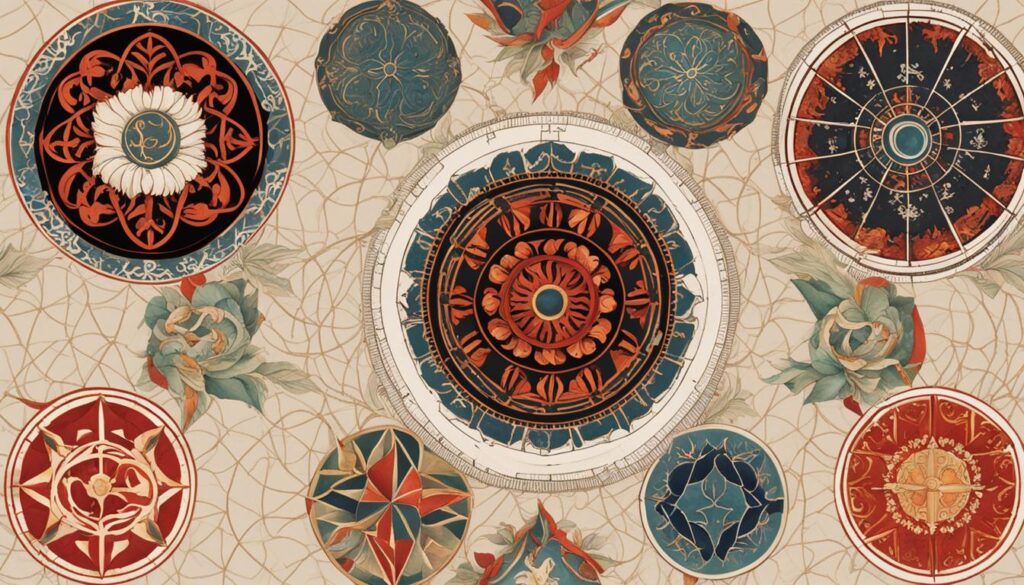
How Zodiac Signs Interact in Relationships
Understanding zodiac sign compatibility can provide valuable insights into how different signs interact in relationships. While compatibility is complex and depends on various factors, including the entire birth chart, considering the elements associated with each sign can give us a general idea of their compatibility.
Fire Signs and Air Signs
Fire signs, such as Aries, Leo, and Sagittarius, share a passionate and energetic nature. They are often drawn to air signs, including Gemini, Libra, and Aquarius, who possess intellectual curiosity and enjoy engaging in stimulating conversations. Fire signs can inspire and motivate air signs, while air signs bring a sense of balance and harmony to the relationship.
Earth Signs and Water Signs
Earth signs, like Taurus, Virgo, and Capricorn, are practical and grounded individuals. They often find a natural connection with water signs, including Cancer, Scorpio, and Pisces, who are sensitive and deeply intuitive. Earth signs provide stability and security in the relationship, while water signs offer emotional support and understanding.
Challenges and Growth
While compatibility can be favorable between certain zodiac signs, it’s important to note that challenges and growth opportunities are present in every relationship. These challenges can lead to personal and relational growth if both individuals are willing to communicate, compromise, and understand each other’s needs.
In conclusion, understanding zodiac sign compatibility can provide valuable insights into how different signs interact in relationships. While general guidelines based on the elements associated with each sign can give us a sense of compatibility, it’s important to consider the entire birth chart for a more accurate assessment. By nurturing open communication and embracing the unique qualities of each sign, relationships can thrive and grow.
Exploring Sun Signs and Personality
When it comes to astrology, your sun sign plays a significant role in shaping your personality. Representing your core essence, it determines your basic traits and life’s purpose. Understanding the meaning behind your zodiac sun sign can provide valuable insights into who you are and how you navigate the world.
The sun sign, also known as your star sign, is determined by the month intervals mentioned earlier. Each sign has its own set of characteristics and qualities that contribute to your overall persona. For example, if you have an Aries sun sign, you are likely to be bold, competitive, and driven. Your fiery nature gives you a natural inclination to take charge and pursue your goals with vigor.
However, it’s important to note that while your sun sign is influential, it is not the sole factor that defines you. Other planetary placements, such as your moon and rising signs, also contribute to your unique personality. These different aspects work together to create a multi-dimensional portrait of who you are.
| Zodiac Sign |
Sun Sign Meaning |
| Aries |
Bold, competitive, driven |
| Taurus |
Stable, practical, reliable |
| Gemini |
Intellectual, adaptable, curious |
| Cancer |
Emotional, nurturing, intuitive |
| Leo |
Confident, generous, passionate |
| Virgo |
Detail-oriented, analytical, practical |
| Libra |
Harmonious, diplomatic, social |
| Scorpio |
Intense, mysterious, transformative |
| Sagittarius |
Adventurous, optimistic, philosophical |
| Capricorn |
Ambitious, disciplined, responsible |
| Aquarius |
Independent, innovative, humanitarian |
| Pisces |
Empathetic, intuitive, artistic |
Discovering the meaning behind your sun sign can be an enlightening journey. It helps you embrace your core essence and understand why you may have certain tendencies or preferences. Remember, astrology is a tool for self-reflection and personal growth, allowing you to explore the depths of your personality and uncover hidden strengths within yourself.
Understanding Moon Signs and Emotional Needs
Your moon sign reveals your deepest personal needs, habits, and reactions. It influences your subconscious and emotional responses to various situations. While your sun sign reflects how you present yourself to the world, your moon sign represents your most authentic self and plays a role in predicting your reactions and instincts.
Your moon sign is determined by the position of the moon at the time of your birth. It represents your emotional core and the way you process and express your feelings. Understanding your moon sign can provide valuable insights into your emotional needs and how you navigate relationships and challenges.
Just as the moon’s phases change, your moon sign can also influence your moods and emotional landscape. It shapes your intuitive and nurturing qualities, as well as your instinctual reactions when faced with life’s ups and downs. By embracing and understanding your moon sign, you can gain a deeper understanding of yourself and develop strategies for self-care and emotional well-being.
| Moon Sign |
Meaning |
| Aries |
Assertive, impulsive, and fiercely independent |
| Taurus |
Steadfast, sensual, and in need of stability |
| Gemini |
Intellectual, adaptable, and curious |
| Cancer |
Empathetic, nurturing, and deeply sensitive |
| Leo |
Dramatic, passionate, and seeking validation |
| Virgo |
Analytical, practical, and detail-oriented |
| Libra |
Harmonious, diplomatic, and focused on relationships |
| Scorpio |
Intense, mysterious, and driven by deep emotions |
| Sagittarius |
Optimistic, adventurous, and in search of freedom |
| Capricorn |
Responsible, disciplined, and driven to achieve |
| Aquarius |
Individualistic, open-minded, and focused on progress |
| Pisces |
Intuitive, compassionate, and deeply connected to emotions |
Unveiling Rising Signs and First Impressions
Your rising sign, also known as your ascendant, plays a crucial role in shaping the first impression you make on others. Determined by the zodiac sign rising in the eastern horizon at the time of your birth, your rising sign reveals unique characteristics, defense mechanisms, and your worldview. This information provides valuable insights into understanding yourself and the way you interact with the world around you.
Your rising sign represents the mask you wear when you meet new people and enter unfamiliar situations. It influences your appearance, demeanor, and how you present yourself to others. This sign also highlights your natural defense mechanisms, which serve as protective barriers in the face of challenges or vulnerabilities.
To understand your rising sign, it’s important to have an accurate birth time. With this information, you can use an online birth chart calculator or consult with an astrologer to determine your rising sign. Once you know your rising sign, you can explore its meaning and how it interacts with your sun sign and moon sign to gain a deeper understanding of your personality.
Remember, your rising sign is just one piece of the astrological puzzle. It combines with your sun sign and moon sign to give a more comprehensive picture of who you are. Embracing this knowledge can help you navigate relationships, career choices, and personal growth with a greater sense of self-awareness.
| Rising Sign |
Meaning |
| Aries |
Bold, assertive, energetic |
| Taurus |
Steady, practical, grounded |
| Gemini |
Intellectual, curious, adaptable |
| Cancer |
Nurturing, sensitive, empathetic |
| Leo |
Confident, charismatic, expressive |
| Virgo |
Detail-oriented, analytical, systematic |
| Libra |
Harmonious, diplomatic, social |
| Scorpio |
Intense, secretive, transformative |
| Sagittarius |
Adventurous, optimistic, philosophical |
| Capricorn |
Ambitious, disciplined, responsible |
| Aquarius |
Independent, innovative, humanitarian |
| Pisces |
Compassionate, imaginative, intuitive |
Exploring the Elements in Astrology
Astrology categorizes signs into four elements: fire, earth, air, and water. Each element brings its own set of characteristics and energies to the signs associated with it.
The Fire Signs
Fire signs (Aries, Leo, Sagittarius) are energetic and enthusiastic individuals. They possess a natural spark that ignites passion and excitement in everything they do. Fire signs are known for their boldness, courage, and pioneering spirit. They are often seen as natural leaders, inspiring others with their dynamic personalities.
The Earth Signs
Earth signs (Taurus, Virgo, Capricorn) are grounded and practical individuals. They have a strong sense of responsibility and are reliable and hardworking. Earth signs value stability and are skilled at managing resources and creating a solid foundation. Their down-to-earth nature brings a sense of calm and dependability to those around them.
The Air Signs
Air signs (Gemini, Libra, Aquarius) are intellectual and communicative individuals. They possess a sharp intellect and a love for ideas and knowledge. Air signs are great thinkers and excel in fields that involve writing, speaking, or problem-solving. They are known for their sociability, wit, and ability to view situations from multiple perspectives.
The Water Signs
Water signs (Cancer, Scorpio, Pisces) are deeply emotional and intuitive individuals. They have a strong connection to their emotions and are highly empathetic. Water signs possess a heightened sensitivity and are often able to pick up on the feelings of others. They bring a sense of depth, compassion, and understanding to their interactions.
| Element |
Signs |
| Fire |
Aries, Leo, Sagittarius |
| Earth |
Taurus, Virgo, Capricorn |
| Air |
Gemini, Libra, Aquarius |
| Water |
Cancer, Scorpio, Pisces |
The Power of Fire Signs
Fire signs, including Aries, Leo, and Sagittarius, possess an irresistible energy and passion that sets them apart. They are natural-born leaders who have a knack for taking charge and initiating action. Fire signs are known for their optimism and exuberance, which can be infectious to those around them. They are driven by their desires and are not afraid to pursue their goals with unwavering determination.
One of the prominent traits of fire signs is their enthusiasm. They approach life with a zest and excitement that is hard to match. Fire signs are always seeking new experiences and challenges, as they thrive on the adrenaline rush that comes with pushing their boundaries. Their dynamic and energetic nature makes them magnetic and draws others towards them.
However, it’s important to note that fire signs can sometimes be impulsive. They may be quick to act without fully considering the consequences of their actions. It’s essential for fire signs to learn how to balance their enthusiasm with patience and careful planning. By harnessing their fiery energy effectively, fire signs can achieve incredible success and inspire those around them.

To summarize, fire signs are characterized by their enthusiasm, passion, and exciting energy. They have a natural ability to lead and inspire others. While their impulsive nature may need some guidance, fire signs have the potential to achieve great things and leave a lasting impact.
The Strengths of Earth Signs
Earth signs, which include Taurus, Virgo, and Capricorn, possess a unique set of traits that contribute to their strong and reliable nature. They excel in various areas of life and bring stability and practicality to those around them.
Taurus individuals are known for their grounded nature and unwavering determination. They are often seen as reliable and hardworking individuals who are not afraid to roll up their sleeves and get the job done. The practical approach of Taurus helps them excel in fields that require attention to detail and perseverance. Their love for comfort and security ensures that they create stable and harmonious environments for themselves and others.
Virgo individuals are known for their analytical skills and attention to detail. They have a natural ability to organize and plan, making them excellent problem solvers. Virgos are often drawn to careers that require precision and a methodical approach. Their practical mindset allows them to assess situations objectively and find efficient solutions. They are also known for their loyalty and dedication, making them reliable friends and partners.
Capricorn individuals are ambitious and have a strong work ethic. They are driven by their desire for success and are willing to put in the necessary effort to achieve their goals. Capricorns possess excellent management and leadership skills, making them natural leaders in various fields. Their practicality and ability to navigate challenges with persistence and determination make them dependable and trustworthy individuals.
Table: Earth Signs Traits
| Sign |
Traits |
| Taurus |
Grounded, reliable, determined |
| Virgo |
Analytical, detail-oriented, problem solver |
| Capricorn |
Ambitious, hardworking, dependable |
Earth signs provide a sense of stability and practicality in various aspects of life. Their grounded nature, attention to detail, and reliability make them valuable assets in both personal and professional relationships. Whether it’s creating a secure and comfortable home environment or excelling in their chosen careers, earth signs bring a calm and collected energy that is both reassuring and inspiring.
The Intelligence of Air Signs
Air signs (Gemini, Libra, Aquarius) are known for their intelligence, wit, and a natural inclination towards intellectual pursuits. They possess a sharp mind and are often regarded as quick thinkers. Their ability to analyze information from various angles allows them to see different perspectives and find innovative solutions to problems.
These signs have excellent communication skills and are skilled at expressing themselves clearly and eloquently. They have a natural affinity for words and are often talented writers, speakers, or thinkers. Air signs enjoy engaging in intellectual conversations and are always eager to learn and share knowledge.
“The mind is everything. What you think, you become.” – Buddha
Air signs are curious and inquisitive by nature. They have a thirst for knowledge and are constantly seeking new experiences and ideas. They embrace change and adapt to new situations with ease. Their open-mindedness allows them to embrace different perspectives and consider unconventional ideas.
Air Sign Traits
- Intellectual
- Creative
- Curious
- Open-minded
- Eloquent
- Adaptable
| Sign |
Personality Traits |
| Gemini |
Charming, versatile, curious |
| Libra |
Harmonious, diplomatic, fair-minded |
| Aquarius |
Independent, original, humanitarian |
The Depth of Water Signs
Water signs (Cancer, Scorpio, Pisces) possess unique traits and a depth of personality that sets them apart. These signs are deeply emotional and intuitive, with an innate understanding of the human experience. Water signs have a strong empathetic nature, making them highly attuned to the emotions of others. They possess a natural ability to comfort and support those around them, creating a nurturing and compassionate atmosphere.
What defines water signs is their ability to experience the world with heightened sensitivity. They possess a profound depth of emotion and are often romantic and understanding. Water signs are known for their intuitive nature, which allows them to sense subtle changes in their environment and the people they interact with. This intuition helps them navigate complex emotions and relationships with ease.
Cancer, the first water sign, is deeply nurturing and protective. They have a strong sense of family and are dedicated to creating a safe and loving home. Scorpio, the second water sign, is passionate and intense, with a natural magnetism that draws others toward them. They possess a keen ability to uncover hidden truths and are fascinated by the mysteries of life. Pisces, the final water sign, is imaginative and compassionate. They have a deep connection to the spiritual realm and often possess a creative and artistic flair.
In summary, water signs bring depth, emotion, and intuition to the zodiac. Their empathetic nature and profound understanding of human emotion make them invaluable in relationships and friendships. Water signs navigate the ever-changing tides of life with grace and sensitivity, adding a touch of magic and mystery to the world.
FAQ
How many astrology signs or zodiac signs are there?
The zodiac is composed of 12 signs: Aries, Taurus, Gemini, Cancer, Leo, Virgo, Libra, Scorpio, Sagittarius, Capricorn, Aquarius, and Pisces.
What do zodiac sign dates mean?
Zodiac sign dates are determined by an individual’s date of birth. Each zodiac sign has specific date ranges associated with it, which helps determine a person’s sun sign and personality traits.
Can you provide an overview of each zodiac sign?
Certainly! Here’s a brief overview of each sign: Aries is bold and competitive, Taurus is grounded and practical, Gemini is intellectual and communicative, Cancer is emotional and intuitive, Leo is confident and charismatic, Virgo is analytical and detail-oriented, Libra is diplomatic and harmonious, Scorpio is passionate and mysterious, Sagittarius is adventurous and optimistic, Capricorn is ambitious and responsible, Aquarius is independent and eccentric, and Pisces is compassionate and imaginative.
How do zodiac signs interact in relationships?
In general, signs that share the same element have good compatibility. Fire signs (Aries, Leo, Sagittarius) tend to go well with air signs (Gemini, Libra, Aquarius), while earth signs (Taurus, Virgo, Capricorn) often match with water signs (Cancer, Scorpio, Pisces). However, a more accurate assessment of compatibility considers the entire birth chart, including moon and rising signs.
What is a sun sign and how does it relate to personality?
Your sun sign represents your core personality traits and life’s purpose based on the month intervals mentioned earlier. It reveals the anchor of your personality and how you present yourself to the world. However, other placements like moon and rising signs also contribute to your overall character.
What does a moon sign represent?
Your moon sign reveals your deepest personal needs, habits, and reactions. It influences your subconscious and emotional responses to various situations. While your sun sign reflects how you present yourself, your moon sign represents your most authentic self and predicts your reactions and instincts.
What is a rising sign and how does it affect first impressions?
Your rising sign, or ascendant, is determined by the zodiac sign rising in the eastern horizon at the time of your birth. It influences the impression you make on others when they first meet you and reveals your defense mechanisms and worldview. It takes into account personal experiences and patterns to shape your expectations in various situations.
How are astrology signs categorized?
Astrology categorizes signs into four elements: fire, earth, air, and water. Fire signs (Aries, Leo, Sagittarius) are energetic and enthusiastic. Earth signs (Taurus, Virgo, Capricorn) are grounded and practical. Air signs (Gemini, Libra, Aquarius) are intellectual and communicative. Water signs (Cancer, Scorpio, Pisces) are emotional and intuitive. Each element brings its own set of characteristics and energies to the signs associated with it.
What are the traits of fire signs?
Fire signs (Aries, Leo, Sagittarius) are known for their enthusiasm, passion, and exciting energy. They are often seen as leaders and have a natural ability to initiate action. However, they can sometimes be impulsive and may need reminders to pace themselves.
What are the strengths of earth signs?
Earth signs (Taurus, Virgo, Capricorn) are practical, reliable, and hardworking individuals. They value stability and are skilled at managing finances. However, their tendency to resist change can make them stubborn. They bring a calm and collected energy to those around them.
What are the characteristics of air signs?
Air signs (Gemini, Libra, Aquarius) possess intelligence, wit, and a love for intellectual pursuits. They are natural communicators and often excel in fields that involve writing, speaking, or thinking. Air signs can be dreamers, seeking to process and analyze information from various angles.
How would you describe water signs?
Water signs (Cancer, Scorpio, Pisces) are deeply emotional and intuitive individuals. They have a strong empathetic nature and are highly attuned to the emotions of others. Water signs experience the world with heightened sensitivity and are often romantic and understanding.
Source Links
